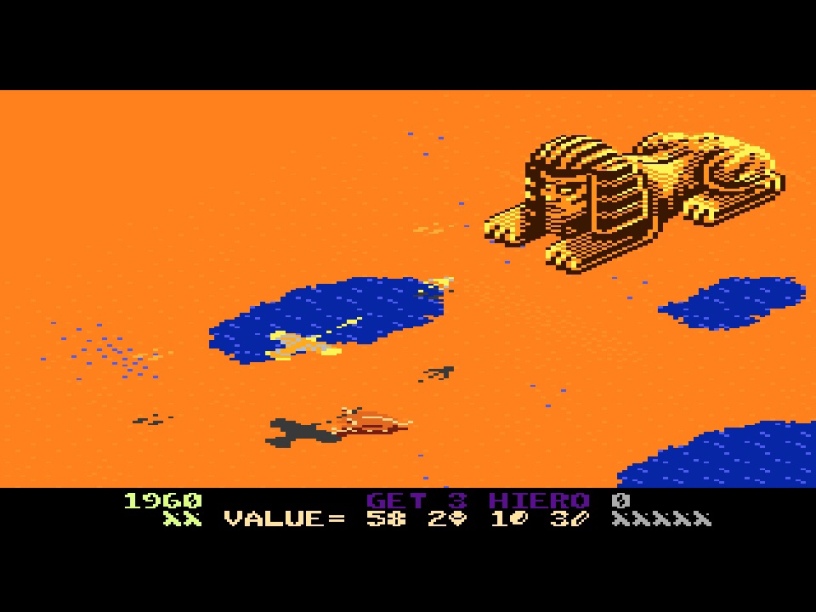I can pinpoint exactly where my fascination with Ancient Egypt started… kind of! It was a book about the seven wonders of the world that sat on the small set of shelves that filled the space that was once the serving hatch between our dining room and the original 1930s terrace cupboard-sized kitchen before it was extended. Also in that space was a framed illustrated postcard of The Devil’s Chimney at the south-east tip of the Isle of Wight, a narrow cleft in a cliff with a very steep set of rickety steps down to the beach that you can imagine moonlit smugglers traipsing up and down, although in reality it probably wasn’t the most practical drop-off point for their big barrels of illicit booty! It was where 500 French soldiers attempted an invasion in 1545 though, only to be turned away by a much smaller number of makeshift local militia, but that’s another tale; I’ve still got the postcard though, albeit in a different frame now! Those shelves also housed a small ashtray with a picture of a Roman mosaic on it, which, by total coincidence, is currently home to a set of Roman nails in my garage, and there were some other books – specifically, 1979’s The Pocket Book of Houseplants and a couple that my fellow cactus-loving Grandad had given me: Cacti and Succulents from 1953 and Cacti for Decoration from 1956; and they’re are all now sitting on a bookshelf right next to me (and beneath the Devil’s Chimney postcard) as I write this! Unfortunately, I can’t be specific about the actual book in question though, because despite searching through way more boxes for way longer than this rambling paragraph deserves, I can’t only not find it, but I can’t find a trace of it on the internet either! An illustration of the Sphinx and pyramids on the cover, softback but formatted like a small encyclopaedia and I reckon it would have been published around 1980 by someone like Usborne, just in case it rings any bells!

Anyway, every Sunday when we all had to sit at the table for our Sunday roast, I’d be flicking through that book while I waited for dinner to arrive, but never getting far beyond the awe-inspiring mysteries of The Great Pyramid of Giza. Those few pages would eventually evolve into what’s now a small library on the subject, covering the spread of its civilisation and its great pharaohs; its breath-taking architecture and impossible technology; its language and art and incredible symbolism; its preoccupation with death; its magic and gods; but mostly its secrets, and the ongoing journey of discovery to literally unearth its truths and unravel those eternal mysteries that started it all. I’d eventually make the first of eight (to date) visits there in 1997 with my then girlfriend and now wife – our first holiday together, and while it was done on a shoestring with a Lonely Planet guidebook, for better or worse we saw everything; actually, looking back now it could really have been a lot worse… One of the maddest things we ever did was book a night train from Luxor to Cairo to see the pyramids; the last time we went, travelling to Cairo on organised trips involved buses with armed guards travelling in convoy, but we spent about eight hours in the coldest, noisiest, most uncomfortable train you can imagine, being eyed at during every one of its remote stops by the mass of what we felt were undoubtably (but undoubtably totally unjustifiably!) the worst of Egypt’s Indiana Jones-inspired criminal underworld! Absolutely terrifying trip, and the worst of it was that we had to go back the other way the following night!

Our next time back was in 2001 and that was terrifying in a different way, as I was doing my utmost to fly casual and not have my bag searched in security, causing the engagement ring hidden away in there to be revealed prematurely! We’d now bought a flat in East London together, and while money was still a bit tight, we were doing well enough that we weren’t only having dinner every other night this time, and we’d decided to go on proper trips with the holiday company rather than the terror express, or seat-of-your-pants journeys with mad taxi drivers that used their horns at night instead of lights, and once you used them once they were forever your driver whether you liked it or not! Apart from the haggling and the constant tipping every time someone so much as breathes in your direction, this trip to the Valley of the Kings was far more civilised (if equally, ridiculously hot), and that’s where I managed to stop having to hide that ring, exactly as planned inside Tutankhamun’s tomb!

And that’s probably enough of my history with Egypt to justify me playing an old Atari game, but I will quickly highlight just quite how fascinating I still find the subject by saying I still play the absolutely dreadful third installment of my top-five favourite game of all time Renegade, just to see its glorious Commodore 64 take on an Egyptian tomb again! Going back to the time though, I guess Mastertronic’s King Tut for the VIC-20 was my first taste of gaming Egypt, a terrifying treasure-hunting maze game in a more primitive but still very atmospheric tomb full of scorpions and bugs out to kill you, and was really impressive at the time (and for a budget game) for the dynamic lighting from the lamp in your hand and some very detailed sprites.
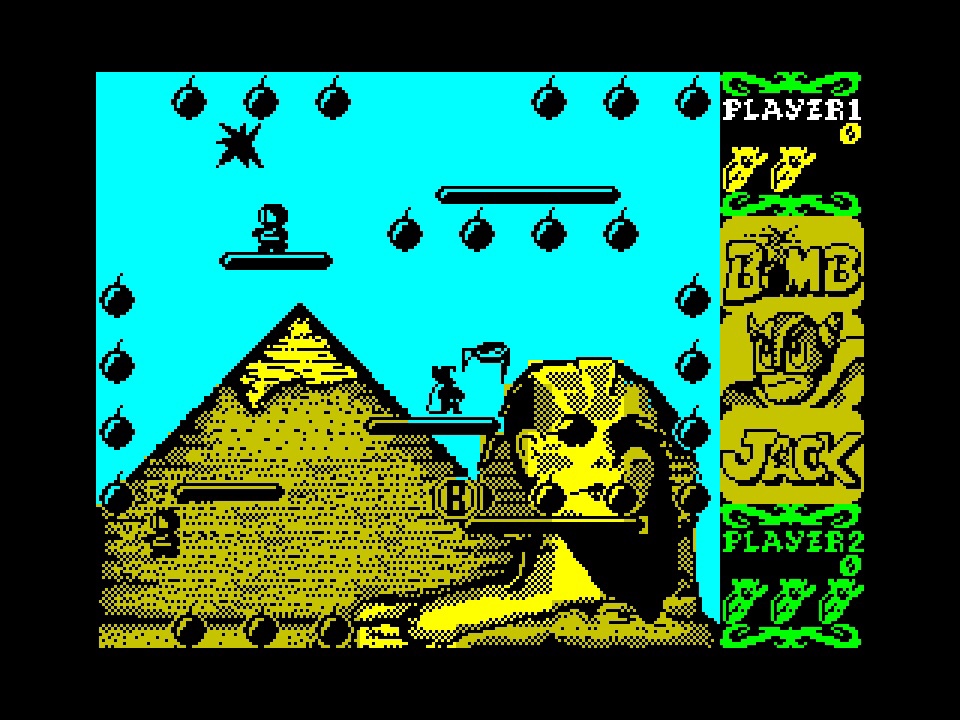
Oh Mummy was in the box of mostly otherwise crappy games that came with the Spectrum +2, a spin on the kind of reverse Pac-Man 1981 arcade game Amidar where you run around each element of the maze and once it’s surrounded by footprints it reveals its treasure as you’re being chased away by mummies. It’s very simple but remains incredibly addictive! Side-scrolling Fighting Warrior on there had some very evocative Egyptian backgrounds, and I’ve just done some digging on a nagging memory to finally remember that Top Gear 2 on the SNES does too, but if we’re talking Egyptian backgrounds we need to head back to the Spectrum and look no further than the first screen of Bomb Jack, one of the great arcade ports and also, in my opinion, a better looking Sphinx and Great Pyramid than even the original managed – at the very least, I don’t think anyone would disagree it’s better than the pile of crap that came out for the Amiga a bit later!
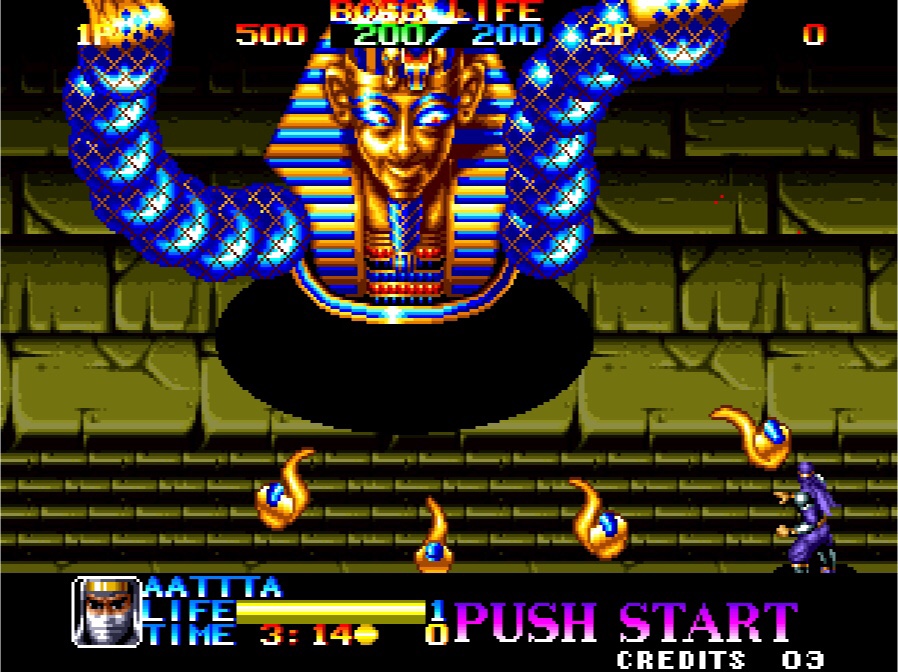
There’s a few more arcade games that deserve a mention for some great-looking Egyptian themed levels too. Ninja Commando is a 1992 Neo-Geo vertical run and gun shooter that has you time travelling to what I think is a random order of three eras after the first stage boss – the Stone Age, Feudal Japan and Ancient Egypt. The gameplay is fun if not massively memorable, but it’s a looker whenever or wherever you end up, and has the best Tutankhamen death mask boss you’ll ever see in a game! Then there’s Arabian Fight, which I only came across when I picked up the marvellous Sega Astro City Mini and my first impressions were more style than substance. It’s a scrolling brawler from 1991 that seems to be based on the old Sinbad movies, and while it’s not as fluent as something like Streets of Rage, give it a few goes to click and you’ll be treated to some lovely “Arabian” settings that take you from a pyramid-strewn desert and into a tomb, where the flat 2D warriors in the wall paintings come to life to fight, but still as flat 2D sprites against this clever sprite-scaled 3D environment. Not the best brawler ever, but definitely worth a play to experience the journey. Okay, I was also going to touch on Super Mario Land’s Game Boy sphinx action, World Series Perfect’s pyramids under construction, OutRun 2006’s Cairo level, Sandopolis in Sonic & Knuckles, Big Karnak’s Ancient Egyptian take on Ghouls ‘n Ghosts, Red Earth and the gaudy embalmed violence of a couple of Darkstalkers games as well, but we’re already running long and I’m sure they’ll pop up somewhere else sometime…

Right, let’s head on over to the Atari 7800. Just about my first experience with this machine wasn’t playing it back in the mid-eighties, but a wonderful book, Atari 2600/7800: a visual compendium by Bitmap Books, that I received from my aforementioned and now long-suffering wife for Christmas 2021. Long story short, it was an instant and massive hit with me, not just for the huge dose of Atari 2600 nostalgia within its sumptuous 528 pages, but also a sense of discovery not felt since Howard Carter stumbled across his “wonderful things” in Tutankhamen’s tomb long before it became a place of sinister romance, as I explored this troubled obscurity and its meagre game library. I liked it so much I wanted to write about it, so I reviewed it here if you do fancy the long story long! If not, the format of the Atari 7800 bit of my review took in examples of something familiar – even if I’d not played it – for example, Alien Brigade (albeit only familiar for ripping off Operation Wolf!), and also something I’d never heard of, which wasn’t going to be hard on this system, so when I was confronted by a huge, full colour, double-page spread half-filled by an enormous 8-bit Sphinx boss, you know exactly where this was going!
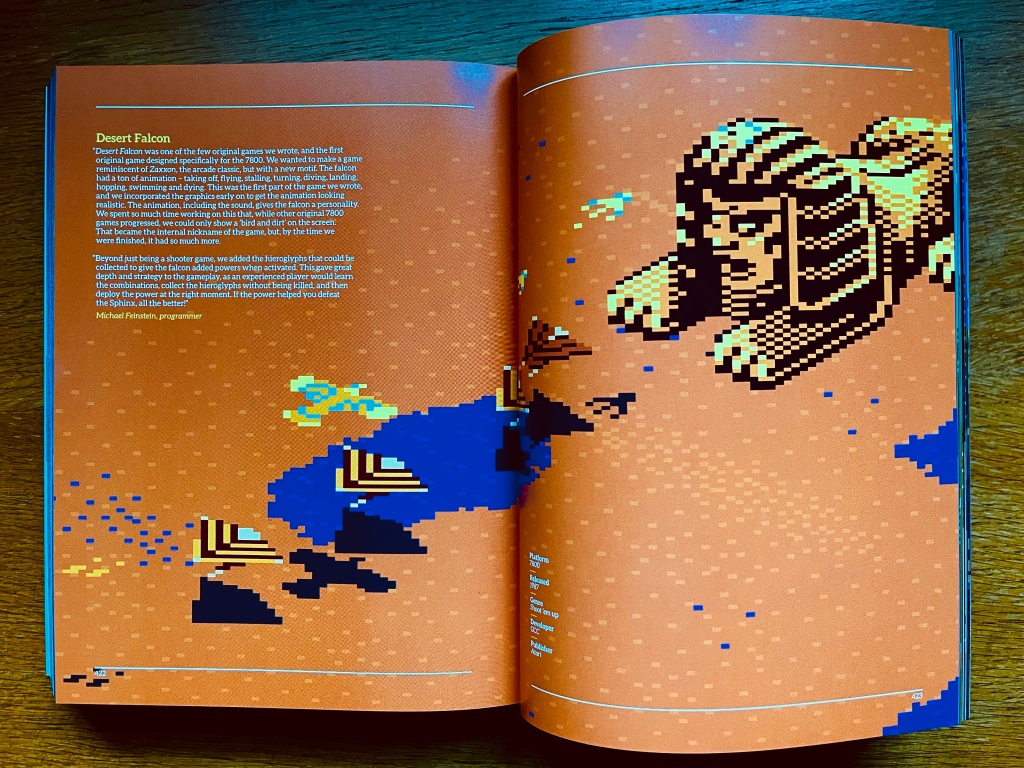
As I’ve still got the book to hand, let’s take a look at what programmer, Michael Feinstein (I assume of General Computer Corporation), had to tell us about the game… “Desert Falcon was one of the few original games we wrote, and the first original game designed specifically for the 7800. We wanted to make a game reminiscent of Zaxxon, the arcade classic, but with a new motif.” He then goes on to talk about one the first things that really struck me with Desert Falcon, and that’s the animation of the falcon itself – there’s loads of it! There’s taking off and flying, stalling and turning, diving and landing, and on the ground you’re either hopping or swimming, and, of course, there’s plenty of dying too! That was apparently the first part of the game they wrote, and they went to town on getting it all realistic and giving the falcon a personality; in fact, they spent so long on that bit that while the other twelve games in the very original Atari 7800 line-up were progressing towards being actual games, they could only show a “bird and dirt” on the screen. So that’s what it was then nicknamed in the development team!
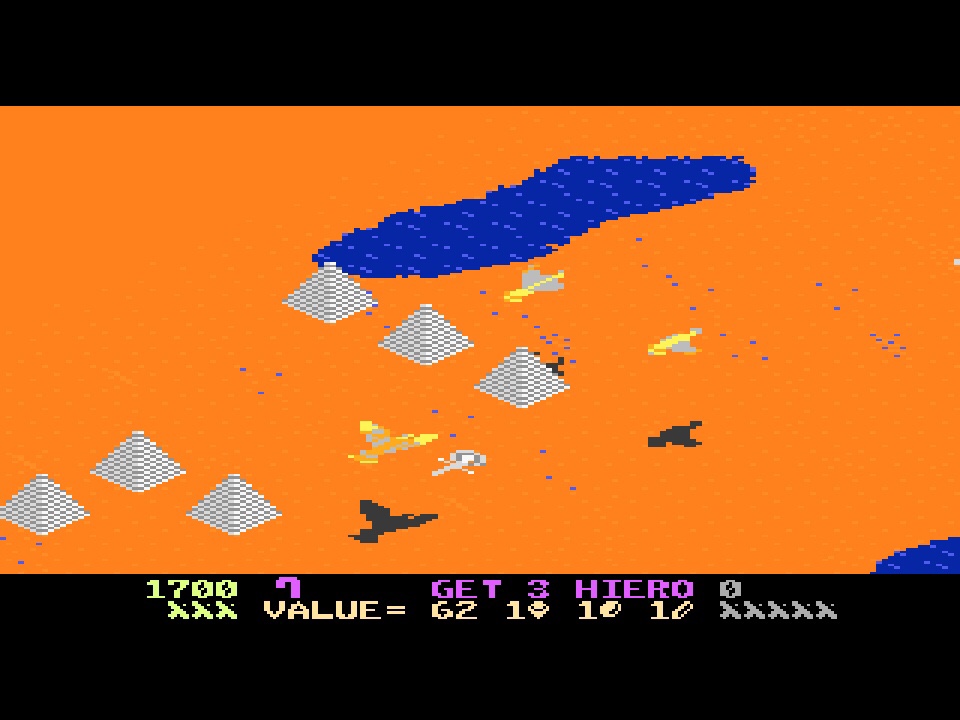
Whether or not Bird and Dirt, or Sphinx, or Nile Flyer, or even Desert Falcon did make it in time for the console launch in June 1984 didn’t really matter in the end! Atari was sold off by Warner Communication to Jack Tramiel the following month, meaning the 7800 was shelved – literally, including the initial production run – until May 1986. Desert Falcon would then further languish until December 1987, when it was finally published by this new Atari for both the 7800 and the 2600, and we’ll come back to the latter I’m sure! In the meantime, let’s quickly check the back of the box blurb… “You are the royal Desert Falcon questing for precious gems and Egyptian hieroglyphs hidden in the endless desert. Invincibility, warp speed, and quick shots are only some of the many magical powers you’ll gain on your search. Use them to capture a trove of treasures. But watch out for the evil ones! Mythical flying beasts, blazing firepots, and howling sphinxes guard the jewels you seek.” I like to think I was a writer for the back of a box in a past life – they’re always priceless! Speaking of which, it also tells us we can expect realistic sound effects and colourful arcade-quality graphics, but we’ll come back to those too…
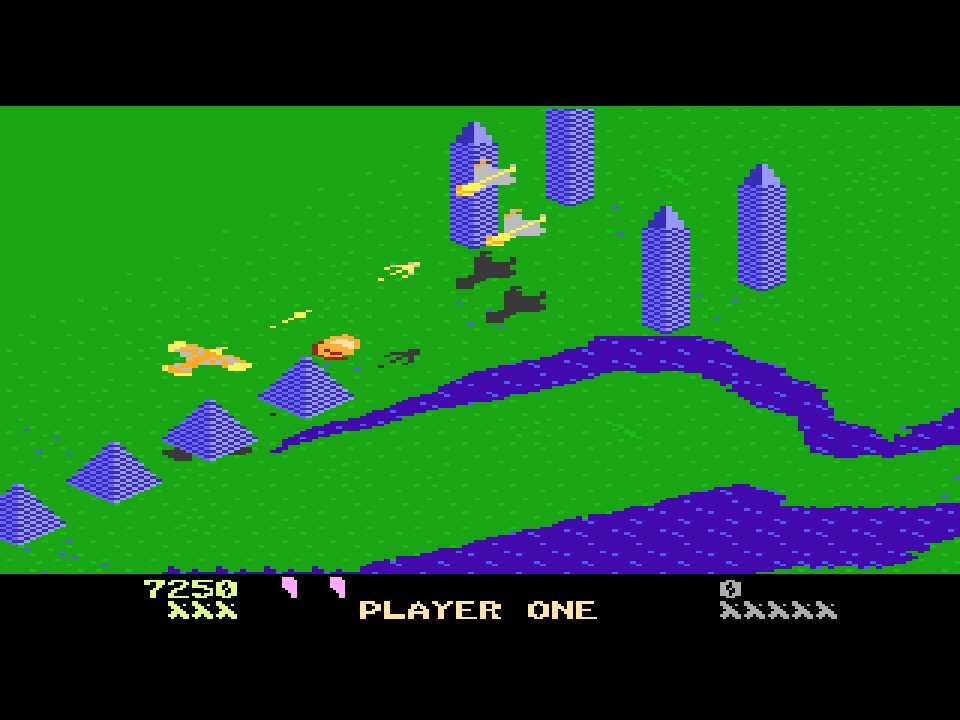
You can always rely on an old Atari instruction manual to take the tale a step further, and Desert Falcon doesn’t disappoint! “All around you are long stretches of sand, ancient pyramids baking in the hot, dead air, and constant danger. The legends that brought you here are 30 centuries old. The tales tell of thieves who plundered the Pharoah’s tomb, loading bags of gold, silver, and precious gems onto their camels, then making off into the desert. But in the night, horrible desert beasts pursued the robbers, and the priceless treasure was scattered and lost. Not even a camel was ever seen again. Now you search for the treasure, daring the beaks and claws of the desert guardians. As you scan the endless sand for the glitter of jewels, your eye catches the sight of gliding shadows. Something’s coming! You could turn back now and be safe. Or you could go on, and dare to steal the Pharoah’s jewels.”

In other words, you’re faced with an isometrically-scrolling arcade shooter, a bit like Zaxxon but in Egypt! It does have a couple of tricks up its own sleeves though. The Pharoah’s big gems, golden eggs and silver ingots are scattered among the obelisks and pyramids, and this is where the points are, so as well as soaring above the sands shooting arrows at vultures, flying fish and other aerial beasties out to get you, you’re also going to be landing, hopping and swimming to grab them. No respite down there though, because the treasures are guarded by swarms of scarabs that won’t let you hang around on the ground, and all of those birds are going to be swooping low at you too. The buildings down there will shield you from some of it, but stay away from them while you’re flying or that’s one of your five lives going splat, although as you’d expect, the death animation is really nice! Further on, you’ll also encounter flame-throwing fire pots and dart-shooting mini-sphinxes, but before that you need to get past the end of level Howling Sphinx! This boss takes a direct shot between the eyes to take down, but getting that shot away isn’t so easy while you’re avoiding the darts and nasty creatures its spitting out at you!
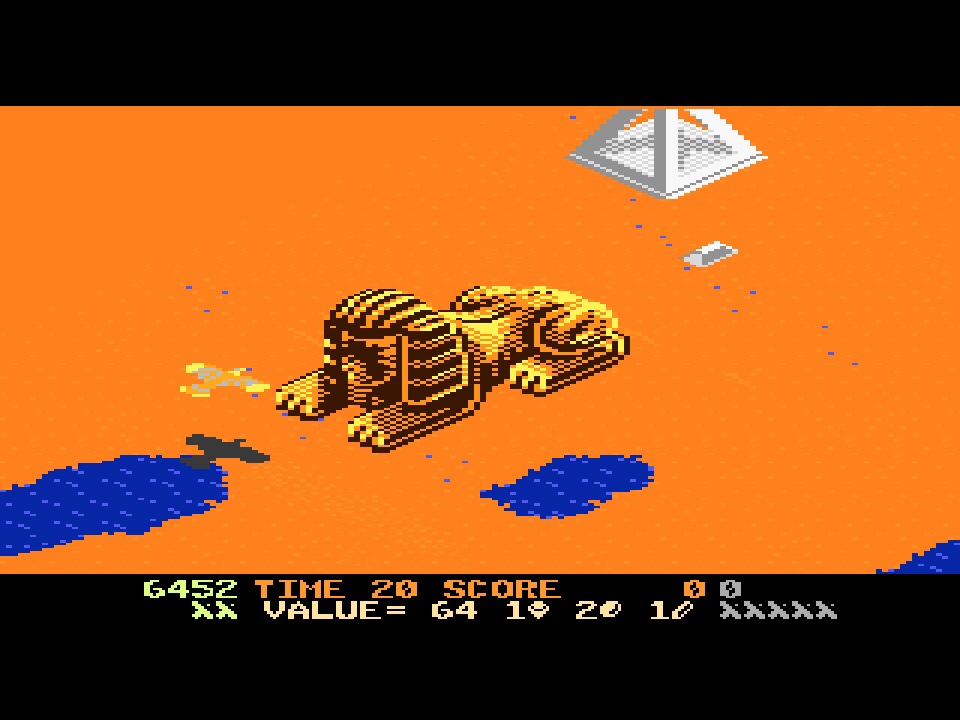
Beat the Howling Sphinx and you’re treated to a bonus round, where there’s treasure all over the place and no enemies, but just a timer counting down to the start of the next level. And then you’re off to do it all again, but it’s harder this time… and most likely a bit more psychedelic too! While the first level might be all the classic hues of a desert journey, subsequent ones mix things up with all kinds of colour combinations that in reality are just adding some variety to the mostly repeating environment, with partially or fully green areas, or night rather than day, but all the same, there’s a few wild choices in there! And while things are repeating, you can’t help but be impressed by the flourishes that give it life above and beyond that wonderful animation we heard about earlier, from the complex textures on the obelisks and exposed geometries of some of the pyramids to the more simple tufts of grass or the ripples on water. As well as the possibly excessive care that’s gone into your falcon (not to mention its realistic shadow that brilliantly helps you gauge height as well as horizontal position), there’s surprising detail in some of the enemy designs too, particularly when you look closely at the ground-based scarabs, and also those fire pots, with realistic flames extending from them into the sky. It’s those huge Howling Sphinxes that are the real start of the show though – their scale by itself is outstanding, but the mere existence of its headdress and ornamental beard would be impressive enough, let alone how much detail you’ll find in each, and then there’s its scowling, shaking face and the lighting… If only it had appeared in 1984 as originally planned, we’d have been blown away seeing that on a home computer – would have been up there with the Gorf mothership on VIC-20!
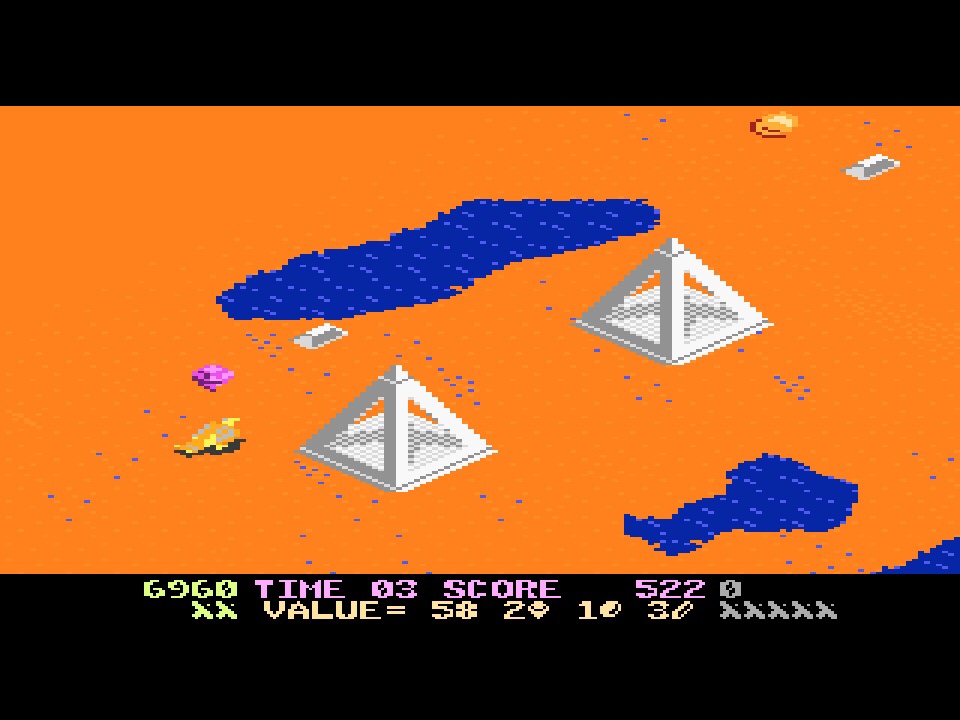
Much like its generic arcade sound effects, as far as gameplay goes though, I think it would probably have felt like as much of an Egyptian relic in 1984 as it would have in 1987. We’d had Zaxxon since 1981 – a lifetime ago in gaming terms at the time – and between 1981 and 1985 that had been ported absolutely everywhere; even the Dragon 32 had a version! And Desert Falcon plays pretty much like a less frantic Zaxxon, which is partially down to its setting, and partially (and intentionally) down to its treasure hunting on the ground, which is its own thing. And while you’re down there, it’s not just collecting treasure doing its own thing – there’s also the hieroglyph system! Hop over any three hieroglyphs (ankhs, eyes, feathers and so on) scattered in the sand and you’ll gain a superpower, which include a screen-clearing air-bomb, decoys, sphinx paralysis, invincibility and a really cool warp that flies you at light speed right into the next Howling Sphinx’s face! The trick is trying to work out which combination delivers which superpower, and that makes for some nice experimentation and also the occasional risk-taking when you see the one you need is buried exactly where you don’t want to go!
All that said, my best run on Desert Falcon was the one where I decided to ignore everything on the ground and just play it like Zaxxon! I think if you’re serious about high scores that’s probably not the way to do it though, and I’d honestly recommend playing Zaxxon if that’s what you want! But while this might be a bit of a rip-off, and it’s definitely a bit of a relic as a result, that doesn’t mean it’s not fun, especially when you’ll take Ancient Egypt over outer space every time!

Before we finish, we have to take a look at that Atari 2600 version! Let’s start at the beginning – the falcon animation is great here too! It also scrolls really smoothly, but that’s possibly down to the lack of much to scroll past… it’s very bare-bones, with only really one very simple building and the occasional enemy on the screen at any time; the enemies are little more than coloured blocks too, making it very easy to miss them randomly flying at you out of nowhere. The hieroglyph system is intact though, and I really liked the double-tap activation on the single fire button. They didn’t forget the Howling Sphinx either! It’s still huge and just as striking when you’re suddenly confronted by it, and the way they’ve realised it is very clever, but it’s obviously lost the detail, and its face reminded me of one of those supposed ghost pictures where you might be looking at a face but it might equally also be a tree stump! I love that they’ve attempted it regardless though! And we also have to mention the music – it all sounds way better than the 7800 version, serving up similar bleeps and white noise zaps, but over the top it’s got a mad and very recognisable bit of stereotypical Egyptian music too!
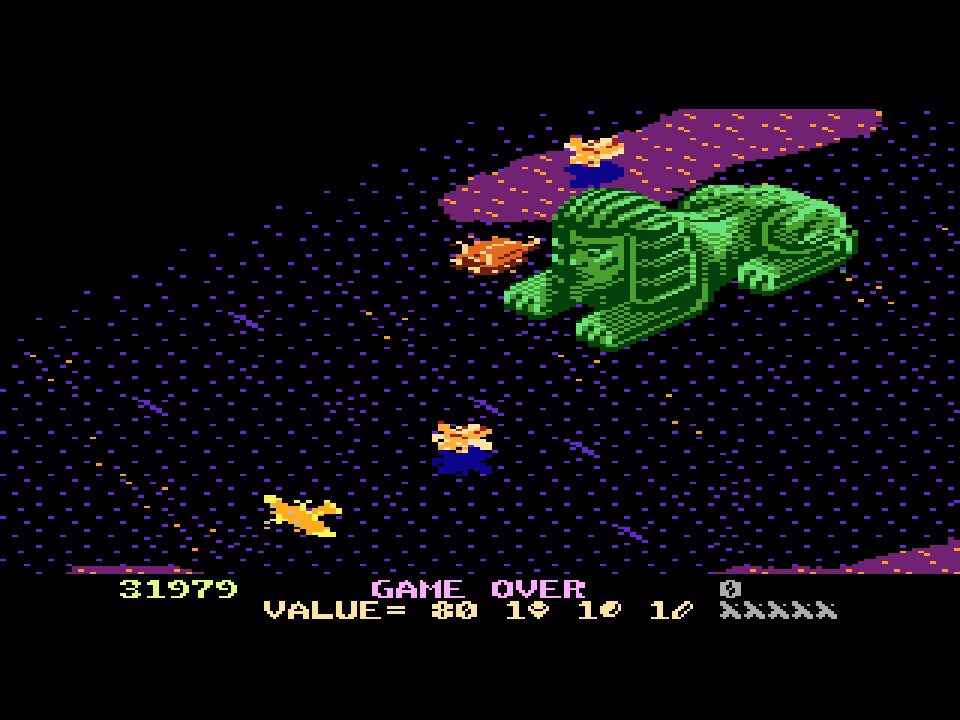
In summary, I’d say go to the Atari 2600 version for the sounds, but for gameplay maybe stick with the 7800 version! And that version is alright. After extended play I think I’d gone around the block about six times, and as far as I can tell it just keeps going – probably with increasingly insane colour palettes! You have got four difficulty levels to keep you interested, although I think in 2022 I’ll be happy just remembering it’s there every now and then and firing it up for a few games. There’s no doubt it’s just the start of my journey of discovery into this machine too – there’s some tantalising ports of stuff like Pole Position II, Xevious and Kung-Fu Master that I’m very keen to try now I’ve had a taste. There’s also the original version of my new nearly-favourite Atari Lynx game, Basketbrawl, and the conversion of Donkey Kong, as well as related all-time favourite Winter Games too! From reading my Atari 2600/7800: a visual compendium book though, I think Enduro Racer-inspired bike racer MotorPsycho might be the one I’m looking forward to the most, and that might well be where we go next right here sometime soon!

